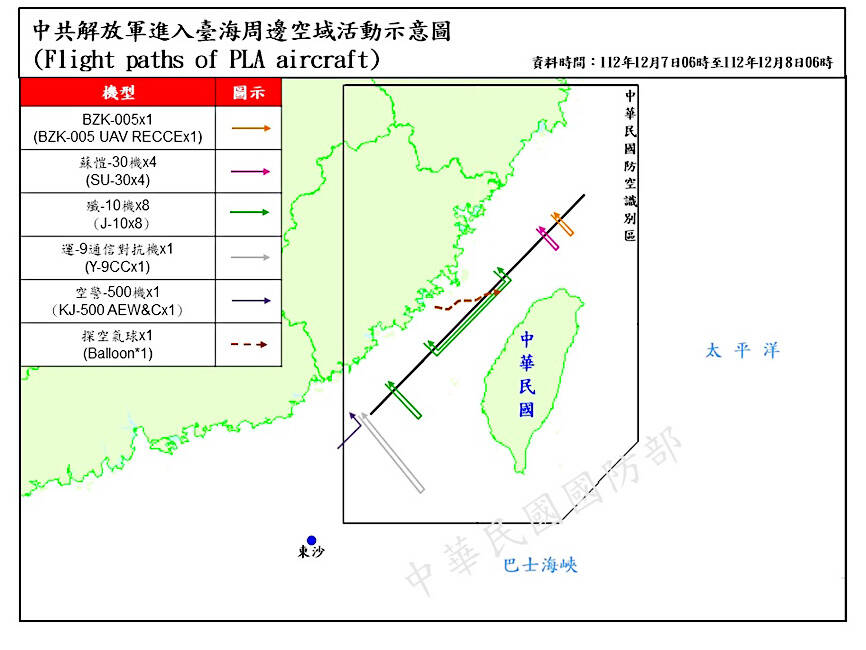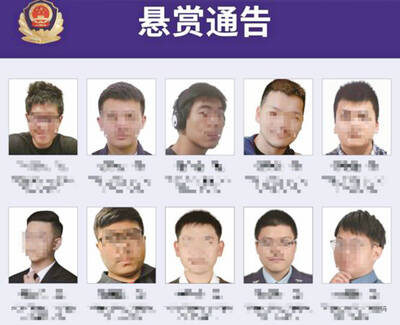The Ministry of National Defense (MND) yesterday said it had detected a Chinese balloon crossing the median line of the Taiwan Strait.
The balloon was detected at 11:52am on Thursday after crossing the median line of the Taiwan Strait 101 nautical miles (187km) southwest of Keelung, the ministry said on X, formerly known as Twitter.
The balloon floated east at an altitude of about 6,400m and disappeared at 12:55pm, it added.

Photo courtesy of the Ministry of National Defense
The ministry included a graphic showing the balloon on a meandering path.
MYSTERY
“Our preliminary understanding is that it might be a sounding or a weather balloon that drifted toward Taiwan due to monsoon winds,” Minister of National Defense Chiu Kuo-cheng (邱國正) told reporters.
Such a balloon could be used for gathering meteorological research data, such as the impact of wind forces, he added.
In Beijing, the Chinese Ministry of National Defense offered no comment, while Chinese Ministry of Foreign Affairs spokesman Wang Wenbin (汪文斌) said: “I’m not aware of the situation, and it is not a diplomatic question.”
On Thursday, the MND reported that it had detected seven Chinese aircraft crossing the median line at 7:30pm.
“The aircraft also conducted a joint combat patrol with [Chinese] vessels,” it said, adding that it had monitored and tasked “land-based missile systems to respond.”
A morning report yesterday said the ministry detected 26 planes in a 24-hour window ending at 6am, 15 of which crossed the median line or entered the southwestern and southeastern parts of the air defense identification zone.
While Beijing sends warplanes and vessels around Taiwan on a near-daily basis, nighttime activity by Chinese aircraft and the appearance of a balloon are rare.
COULD BE A TEST
Institute for National Defense and Security Research defense analyst Su Tzu-yun (蘇紫雲) said there have been instances of small Chinese weather balloons floating above Taiwan proper and outlying areas, which “do not pose a military threat.”
However, Thursday’s balloon “could be a deliberate test,” Su said.
“Besides meteorological purposes, it could also be a deliberate test conducted by the [Chinese] Eastern Theater Command or a political signal,” he said, adding that they could be a form of “political harassment.”
In February, a Chinese spy balloon that flew across the US was shot down by a US fighter jet, causing a diplomatic furor.
The huge balloon, which carried a large payload of electronics, flew over sensitive US military installations and prompted concerns Beijing was scooping up vital intelligence.
A US official said at the time the balloon had multiple antennas, including an array likely capable of collecting and geolocating communications.
China denied that the balloon was to collect intelligence and said it had strayed off course in entering US airspace.
The Pentagon concluded in June that the balloon did not gather data.
Additional reporting by AP

A Chinese aircraft carrier group entered Japan’s economic waters over the weekend, before exiting to conduct drills involving fighter jets, the Japanese Ministry of Defense said yesterday. The Liaoning aircraft carrier, two missile destroyers and one fast combat supply ship sailed about 300km southwest of Japan’s easternmost island of Minamitori on Saturday, a ministry statement said. It was the first time a Chinese aircraft carrier had entered that part of Japan’s exclusive economic zone (EEZ), a ministry spokesman said. “We think the Chinese military is trying to improve its operational capability and ability to conduct operations in distant areas,” the spokesman said. China’s growing

Taiwan yesterday denied Chinese allegations that its military was behind a cyberattack on a technology company in Guangzhou, after city authorities issued warrants for 20 suspects. The Guangzhou Municipal Public Security Bureau earlier yesterday issued warrants for 20 people it identified as members of the Information, Communications and Electronic Force Command (ICEFCOM). The bureau alleged they were behind a May 20 cyberattack targeting the backend system of a self-service facility at the company. “ICEFCOM, under Taiwan’s ruling Democratic Progressive Party, directed the illegal attack,” the warrant says. The bureau placed a bounty of 10,000 yuan (US$1,392) on each of the 20 people named in

Nine retired generals from Taiwan, Japan and the US have been invited to participate in a tabletop exercise hosted by the Taipei School of Economics and Political Science Foundation tomorrow and Wednesday that simulates a potential Chinese invasion of Taiwan in 2030, the foundation said yesterday. The five retired Taiwanese generals would include retired admiral Lee Hsi-min (李喜明), joined by retired US Navy admiral Michael Mullen and former chief of staff of the Japan Self-Defense Forces general Shigeru Iwasaki, it said. The simulation aims to offer strategic insights into regional security and peace in the Taiwan Strait, it added. Foundation chair Huang Huang-hsiung

PUBLIC WARNING: The two students had been tricked into going to Hong Kong for a ‘high-paying’ job, which sent them to a scam center in Cambodia Police warned the public not to trust job advertisements touting high pay abroad following the return of two college students over the weekend who had been trafficked and forced to work at a cyberscam center in Cambodia. The two victims, surnamed Lee (李), 18, and Lin (林), 19, were interviewed by police after landing in Taiwan on Saturday. Taichung’s Chingshui Police Precinct said in a statement yesterday that the two students are good friends, and Lin had suspended her studies after seeing the ad promising good pay to work in Hong Kong. Lee’s grandfather on Thursday reported to police that Lee had sent